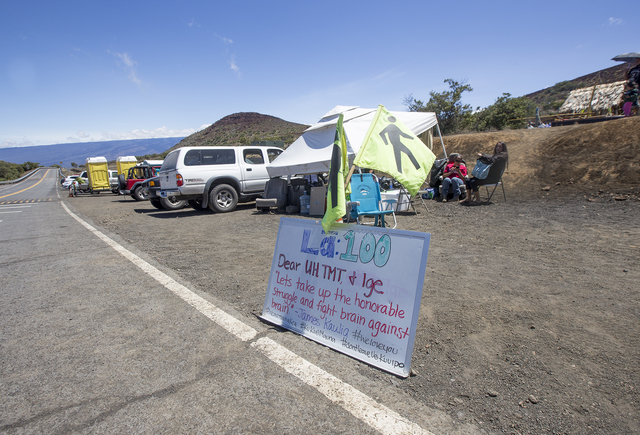The state is proposing to restrict public access to a large portion of Mauna Kea’s summit — the site of recent protests against construction of the Thirty Meter Telescope. ADVERTISING The state is proposing to restrict public access to a
The state is proposing to restrict public access to a large portion of Mauna Kea’s summit — the site of recent protests against construction of the Thirty Meter Telescope.
The Department of Land and Natural Resources drafted new “emergency rules” that would “protect against imminent peril to public safety and natural resources,” according to documents posted Monday on the department’s website.
If approved, the new administrative rules would prohibit certain activities, including camping, within 1 mile of the Mauna Kea Observatory Access Road.
“No person shall at any time bring in to the restricted area or possess or control in the restricted area any of the following items: backpack, tents, blankets, tarpaulins, or other obvious camping paraphernalia,” the draft states.
The proposal also would prevent people from entering or remaining in the area between 8 p.m. and 5 a.m., “except to the extent the person is transiting through the restricted area in a motor vehicle on the Mauna Kea Observatory Access Road.”
The state Land Board is scheduled to discuss the proposed rules during its meeting Friday.
DLNR spokesman Dan Dennison said Monday the department had no further comment about the proposal. He said the state Attorney General’s office was taking the lead on the matter.
Joshua Wisch, a spokesman for Attorney General Doug Chin, said the AG’s office was expecting to put out a detailed news release sometime today.
The draft rules are the latest development in the saga surrounding TMT. Construction of the $1.4 billion project has been at a standstill for several months. On three separate occasions, protesters successfully blocked construction crews from ascending the mountain to begin work.
Since March, protesters, who call themselves protectors of the mountain they consider sacred, have maintained a constant, 24-hour presence outside the Mauna Kea Visitor Information Station.
Reached by phone Monday afternoon, Kahookahi Kanuha, a protest leader, said he had not yet had a chance to review the proposed rules and that he would comment after doing so.
In its submittal to the Land Board, the DLNR’s Division of Forestry and Wildlife writes that within the last two weeks, increasing numbers of people have established overnight, long-term occupancy, as well as established structures and facilities, including tents, encampments, portable restroom facilities and more.
“The long-term residency of those areas by such persons currently poses a risk to public safety by establishing the presence of persons in those very remote areas where they may expose themselves and others to hazardous conditions and severe weather,” the document reads. “Numerous law enforcement actions have taken place in recent days, placing staff, officers and the public at risk.
“The presence of such persons is also resulting in impacts to the natural resources through trampling and other direct impacts, as well as by the accumulation of waste, litter and other disposables.”
Last week, in the wake of additional arrests atop Mauna Kea, Chin said that while he respects those protesters who chose to exercise their First Amendment rights, the state cannot allow people to take the law into their own hands. He said he was working with Gov. David Ige, the University of Hawaii and DLNR to “take all lawful steps to see the road re-opened with safe access to all.”
Mauna Kea Access Road has remained closed to the general public since June 24, when protesters used their bodies and large boulders to prevent construction crews from traveling more than a mile past the visitor center. Eleven people were arrested in the standoff.
Friday’s Land Board meeting begins at 9 a.m. in Honolulu.
Email Chris D’Angelo at cdangelo@hawaiitribune-herald.com.



